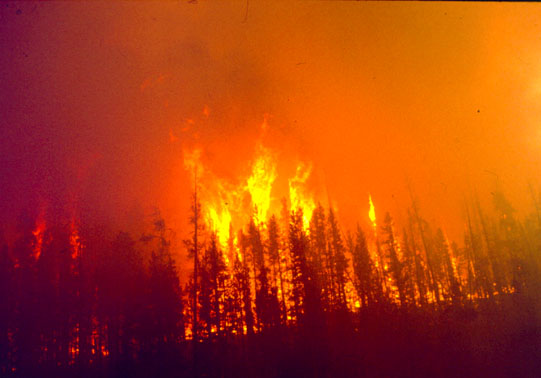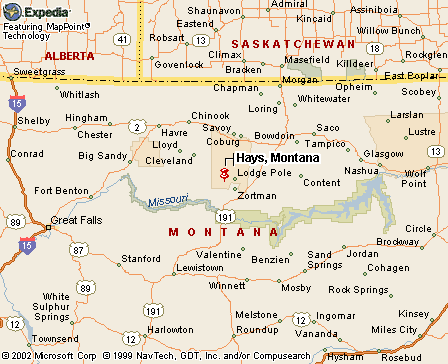|
|
Canku Ota |
|
|
(Many Paths) |
||
|
An Online Newsletter Celebrating Native America |
||
|
June 15, 2002 - Issue 63 |
||
|
|
||
|
Rookie Firefighters Undergo Strenuous Training, Await Fires |
||
|
by Jennifer Perez Great
Falls Tribune
|
||
|
|
|
Rookies from the Fort Belknap, Blackfeet and Rocky Boy's reservations, and urban crews from Helena and Great Falls, have been based at the fire camp in Hays since Sunday. Rookie school is the first rung on the ladder to a wildfire-fighting career. Graduates will be dispatched to fires in the United States and Canada. A quarter of the firefighters are women, said George Stiffarm Sr., fuel specialist for the Bureau of Indian Affairs in Fort Belknap. "That's a good turnout, and, yeah, they're doing a good job, too," Stiffarm said. Instructors taught the rookies four courses at the Hays Lodgepole school: Basic Incidence Command System, Introduction to Fire Behavior, Basic Firefighter and Standards for Survival. The first night, trainees hiked seven miles up and around White Cow Canyon in the Hays area in the rain, Stiffarm said. A cadre of veteran firefighters from the Blackfeet, Fort Belknap, Fort Peck and Rocky Boy's reservations instructed them in field and classroom training. Wilbert Fish, an instructor and Blackfeet herbalist, took crews out on evening walks to teach firefighters how to use plants as antibiotics in the case they get sick on the fire line. Rookies also were taught how to read maps and global positioning systems and how to lay hose and use water pumps. Another rookie school will be held next week in Crow Agency to train firefighters from the Crow, Northern Cheyenne and Fort Peck reservations. Crew boss, crew representative and overhead training and refresher courses, usually held in May, were held in March this year, said Mike LeBrun,environmental coordinator for the BIA Rocky Mountain regional office in Billings. "So we kind of got a jump on the season here, because there was funding available to get our training done early," said Lebrun, also the former assistant fire management officer for the region. The earlier the season the better, because firefighting income is paramount to economies in communities on or near reservations. About 3,500 Montana Indian firefighters grossed $13.5 million in wages during the destructive 2000 fire season. Last
year, $9.3 million was generated by firefighters in the Rocky Mountain
Region, which includes the Blackfeet, Fort Belknap, Fort Peck, Rocky
Boy, Crow and Northern Cheyenne reservations in Montana and the Wind
River Reservation in Wyoming. The Blackfeet firefighters earned about $3.2 million, Fort Belknap $1.4 million, Rocky Boy $973,000 and Great Falls' Big Sky firefighters $183,000. The new crop of rookies are prepared for what looks to be another strong fire season -- many crews are already have fought fires here and in Colorado, New Mexico and California. "Fire season already started in the Southwest," said Ray Nelson, direct fire protection coordinator with the Department of Natural Resources and Conservation. "It usually starts in the southwest in the spring and moves north. Early on, we assist them, and later on ... they assist us." An active year is expected with the severe drought conditions, said Nelson, who is based in the interagency Northern Rockies Fire Coordination Center in Missoula. But the forecast can change as summer approaches. "Fire season depends on what kind of rainfall we can get in the summer months," he said. The majority of fires start in July in Montana and the Northern Rockies region, he said. "That's the bulk of our fire season. The main concern for now in the spring is east of the Continental Divide because they haven't got as much moisture as has the rest of the divide." As the weather gets hotter and drier, he said, it's easier for carelessness to start forest fires, which are expensive, Nelson said. "We have enough to keep us busy chasing lightning starts, we ask people to cooperate by being careful with fire." The Federal Emergency Management Agency VIII has updated its Web site to feature current wildfire news and information. Visit www.usfa.fema.gov . All wildland firefighters must meet minimum levels of fitness requirements for the types of duties to which they are assigned.
|
|
|
||
|
|
||
| Canku Ota is a free Newsletter celebrating Native America, its traditions and accomplishments . We do not provide subscriber or visitor names to anyone. Some articles presented in Canku Ota may contain copyright material. We have received appropriate permissions for republishing any articles. Material appearing here is distributed without profit or monetary gain to those who have expressed an interest. This is in accordance with Title 17 U.S.C. section 107. | ||
|
Canku Ota is a copyright © 2000, 2001, 2002 of Vicki Lockard and Paul Barry. |
||
|
|
|
|
|
The "Canku Ota - A Newsletter Celebrating Native America" web site and its design is the |
||
|
Copyright © 1999, 2000, 2001, 2002 of Paul C. Barry. |
||
|
All Rights Reserved. |
||

 HAYS,
MT - "Nearly 200 rookie firefighters are ready to report for another
busy fire season as they finish training today on the Fort Belknap Indian
Reservation.
HAYS,
MT - "Nearly 200 rookie firefighters are ready to report for another
busy fire season as they finish training today on the Fort Belknap Indian
Reservation. 